.png)
First Published: 18 September, 2019
This isn't a technical post, but understanding how AR can work for your business is easier with an understanding of some of the fundamentals. So from one lay-person to another, here's a rundown on some of the key technologies and terminology that are starting to merge under the umbrella of Augmented Reality. Disclaimer - I'm not a tech guy so here's my attempt at tackling some of the trickier tech concepts.
Computer Vision: One of the most basic yet most powerful capabilities of AR is its ability to connect offline and digital communications. It's not as sexy as some of the other areas of AR but it is still being massively under-utilised. Right now as brands, we have huge spends in both online and offline, but in many cases "never the twain shall meet". We're missing the "whole is greater than the sum of the parts" thing by miles and we're leaving our audiences with too many dots to join. Maybe you've tried QR codes. Maybe even beacons. For me, AR is the tech that finally solves this one.
What we are talking about here is marker-based AR. Where the camera is used to looks for an image, and when it recognises one, it knows what content/information to display. That marker image could be on a DM piece, a catalogue, a billboard or the back of a bus.
The next level for this is object detection where computer vision can identify a 3D object (rather than just a 2D image). Think phone sees shoes on person in cafe, recognises them and overlays information about the shoe - price, available colours, other relevant options, where to buy etc. Visual search is already a thing and mainstream applications such as this are just around the corner.
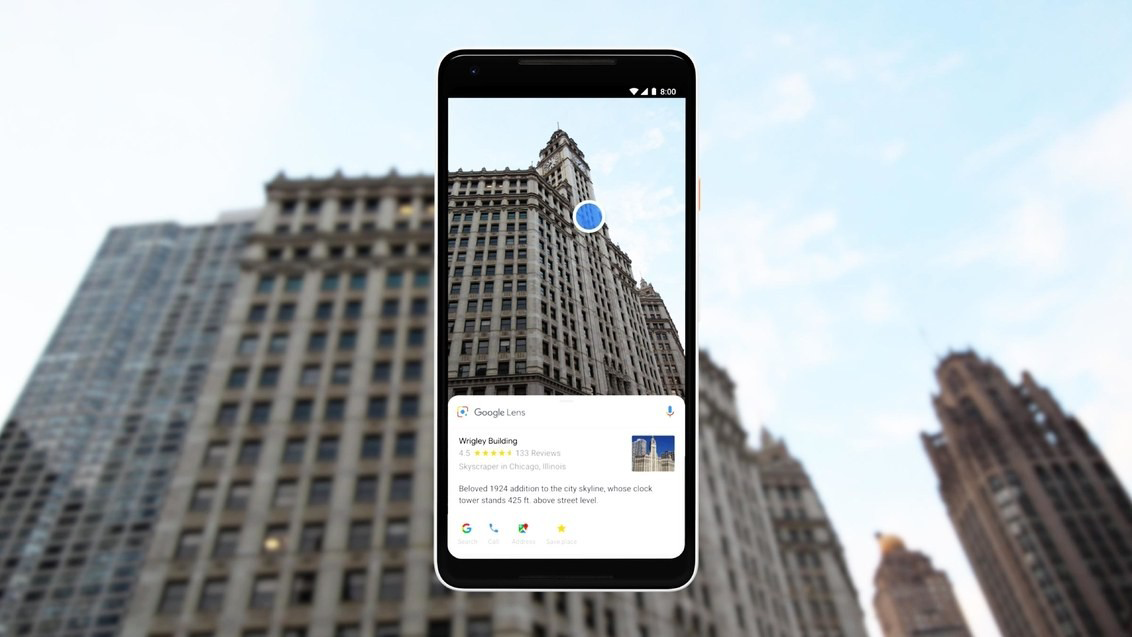
Image Credit: Google
Plane detection: Plane detection moves us beyond the constraints of a physical marker. The camera on your phone looks for a flat surface, either horizontal or vertical (think floor, table, wall), and places the content on there. This is great when you don't want/need a marker to act as the trigger. This capability is built into your phone in the form of ARKit (iOS) and ARCore (Android) but needs an app to use it.
Occlusion: This is getting a bit techy but occlusion will become an important concept as AR evolves. Until recently it has been very difficult to make real and virtual objects behave naturally together. Hiding a virtual object behind a real one - say a real tree in front of a virtual house or a virtual car driving behind a real person. It doesn't sound too important but it's key to making an AR experience truly believable. The latest releases of some of the key technologies are starting to solve this issue but there's still a ways to go...
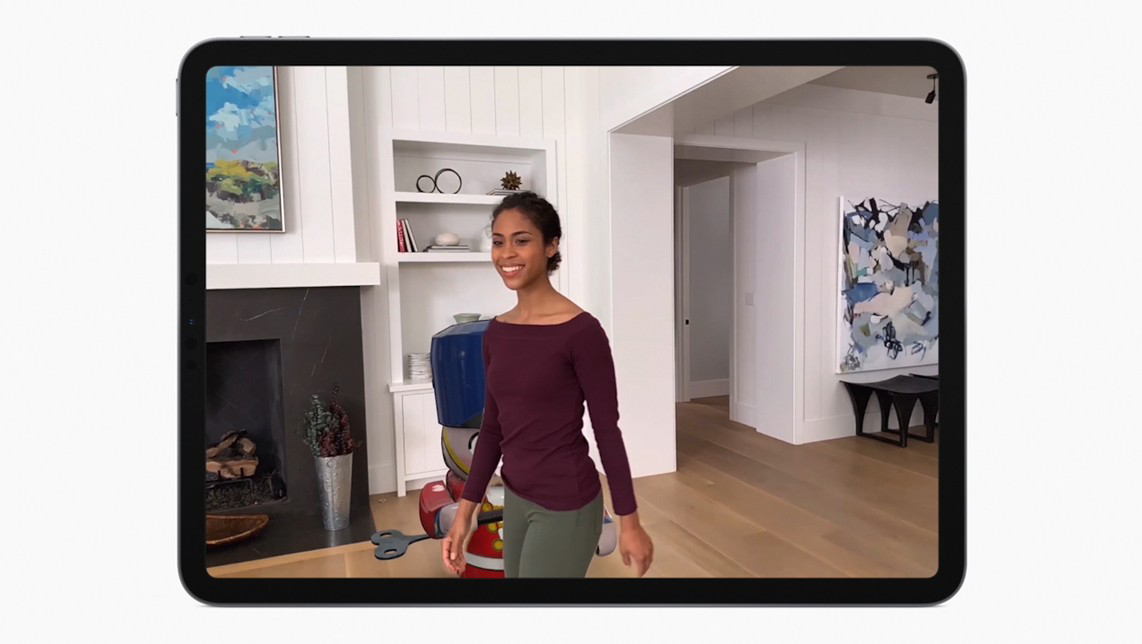
Image Credit: Apple
Spatial Mapping: This is where things get mind-boggling so we won't get in too deep (I couldn't if you wanted me to...). Effectively, through the camera, the device creates a "mesh" of the space you are in (sort of a virtual version) and can then put digital content in the space with an "awareness" of the environment it occupies. This is an important component in solving the occlusion challenge too.
AR Cloud: To quote Ori Inbar who coined the term, the AR Cloud is "a persistent 3D digital copy of the real world to enable sharing of AR experiences across multiple users and devices". This is a massive topic and one I can't do justice to, however, the takeaway for us marketers is, when a digital twin of the world exists, we can place our content in there for people to find/use/consume/explore etc. How this plays out and the societal impacts (I know, heavy stuff) nobody knows and will only be understood in time; but in some ways, it is us marketers who will shape this future so "Do The Right Thing" please people :)
Multiplayer AR: This refers to multiple people being able to enjoy the same experience, in the same place, at the same time, on a different device. Closely linked to spatial mapping and AR cloud, this is something that is starting to emerge in the latest versions of platforms and SDK's and will enable a whole new genre of AR experiences.
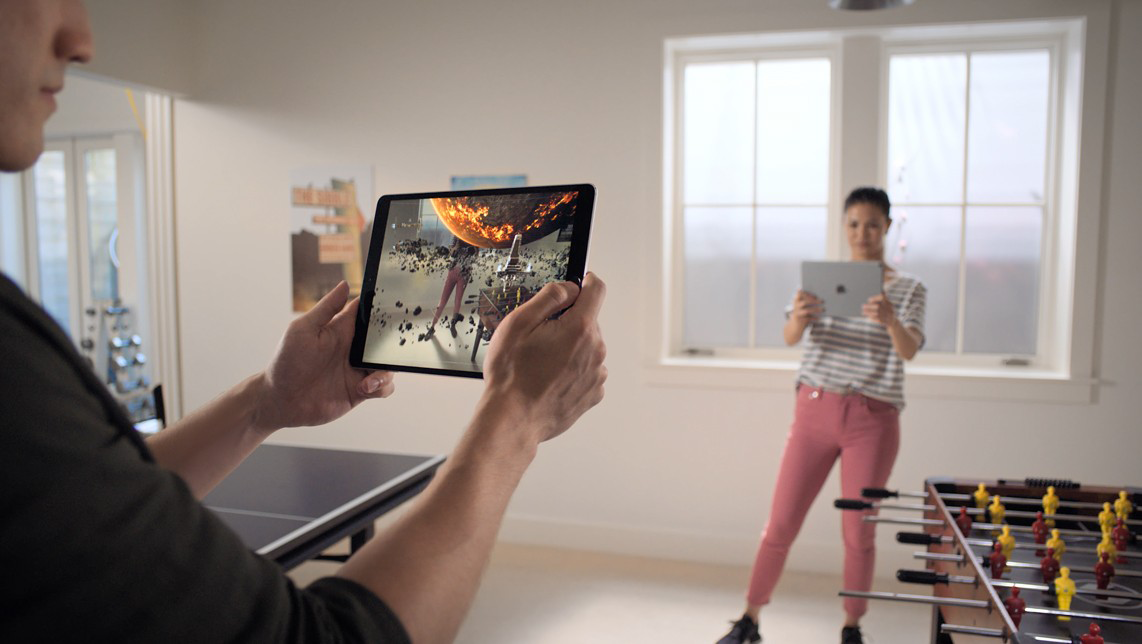
Image Credit: Apple Inc.
webXR: Accessing AR experiences from your mobile browser, without the need for an app looms as a "game-changer" for AR. By removing the last bits of "friction" in the experience we deliver a better user experience and shortening the path to conversion. WebXR means an experience can be triggered directly from a URL, and delivered any way a URL can be delivered - search (text or visual) social media, banner, QR code etc etc. When webXR is really ready is when AR will really hit the mainstream.
I know, when you put it like this it all sounds quite hard. Don't get me wrong, the tech behind AR is extremely tricky stuff. The good news is that there are lots of good platforms and toolkits that handle the tough stuff so that you can focus on the design and creation of the experience.
Next up - a look at some of the options (Note these are just a selection of the many tools and platforms available to play a role in delivering your AR experiences.)
There are many ways in which you can deliver augmented reality solutions. Deciding on a course and a technology depends very much on what you are trying to achieve, however by way of an overview, here are some of the paths available.
If you want to reach a ready-made audience then Snapchat, Facebook and Instagram's AR tools are increasingly accessible from both a technology and pricing perspective. They have their own studio tools for creating AR experiences but if you need help there are plenty of agencies who specialise in these platforms. Of course, it's important to keep in mind that we don't own any audience we capture on these platforms, we're just renting them...
If you'd prefer to build your own audience and retain greater control of the experience then there are plenty of great options available.
If you have access to the capability, then building your own solution will always offer the most flexibility and control. The ARKit and ARCore SDK's from Apple and Google respectively make it possible to embed very powerful AR functionality into your own applications. These tools are becoming more feature-rich with every release.
As an alternative to total native app development, utilising "cross-platform" development frameworks such as those offered by Unity and Unreal. These will give you almost limitless creative possibilities, with some great tools and resources to simplify the development process.
There are of course pros and cons for both approaches and plenty of considerations to take into account, but there's no question that developing your own AR app has gotten a great deal simpler over the last couple of years.
Plattar are some clever guys and girls in Aussie offering an innovative alternative to custom app development. Their mission is to create the "Wordpress for augmented reality", making it possible for the non-developers among us to create our own AR apps. They boast some really big names in their customer list and some really cool solutions have been built on their platform. They also offer early access to webXR via their developer relationships with Apple and Google.
Right now the tool-set is primarily focused on product visualisation/interaction use-cases but I know the guys have a really exciting roadmap that will open up the ability to build many different types of AR experiences. They also have custom-development options that make pretty much anything possible. If I'm honest, the self-service aspect is still being refined so there is a reasonable learning curve for those wishing to create their own AR apps but you always can lean on the support of Plattar's partners (like Blue Star) to help you get up and running.
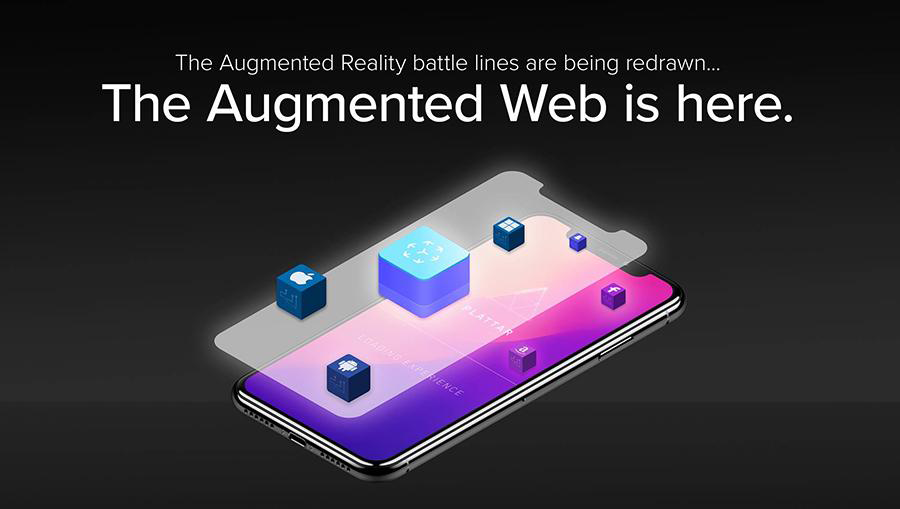
Image Credit: Plattar Pty Ltd
If you're looking for the fastest way to turn your AR ideas into "reality" then perhaps the best of both worlds is offered by the "experience builder" platforms that are available.
Platforms such as Dreemar and Zappar offer powerful studio tools that will enable you to create and publish your own marker-based AR experiences. If you have 3D or even video content available, with these tools you can quickly combine it with printed material, signage or packaging to create powerful marketing and CX initiatives. The studios are pretty functional so you can do a fair bit with them, but if you need additional functionality you can usually engage their in-house development teams for a custom solution.
These tools have their own mobile apps, offering an end-to-end solution that works well if speed to market and/or keeping costs low are the priority. However, they also have the option to custom-brand, or even embed them in your own application, providing the easiest way to deliver a fully branded experience.
At Blue Star, we have chosen Dreemar as the primary platform upon which we build AR solutions for our customers. Not just because they've built a nice, "does-what-it-says-on-the-tin" platform, but also because their support is great and they welcome our input into their product road-map. It's also excellent for "rapid-prototyping" that allows us to deliver working demos to help customers test AR in certain use cases, before making the decision to make further investment.
If you've made it this far I appreciate your perseverance. It is a big topic so to keep it to a semi-readable length I've had to take an almost criminally light touch on each of the areas I've delved into, and some big topics (like content creation) I've not even attempted. For all these things I apologise, however, I'm hopeful that I've gone some way towards summarising where we are at with augmented reality as a marketing tool, the technology landscape and some of the key considerations when it comes to selecting the best place to start.
If you take one thing away please believe this - right now we are in the really sweet spot where AR is very possible but there is huge opportunity to lead and to make your brand (and yourself) stand out. These sorts of opportunities don't come around very often in the lifespan of a marketer. If you missed search and slept on social media this is your shot at redemption. Find a way to get started, learn, get your mojo and build from there.
There hasn't been anything this fun happen to marketing since...pretty much forever.
P.S. If you want to have a tinker with AR we've built a simple little demo. Download the Blue Star AR app (Android here, iOS here) and scan the image below. In this case, we're using a marker as the "trigger" for the experience but the experience is actually using plane detection to run.
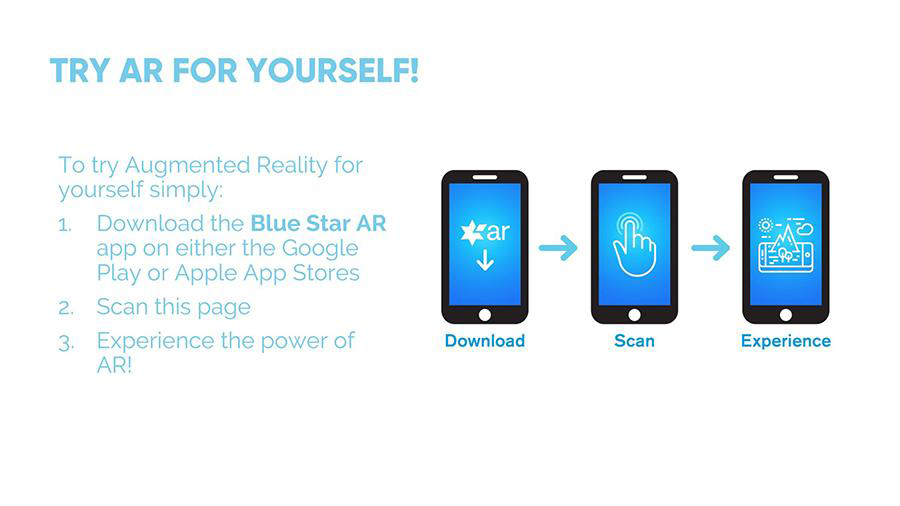

Contact us if you have any suggestions on resources you would like to see more of, or if you have something you think would benefit our members.
Get in TouchSign up to receive updates on events, training and more from the MA.
